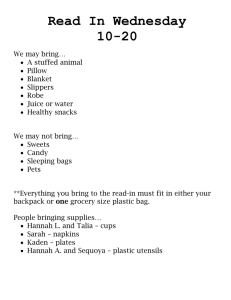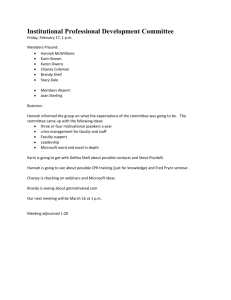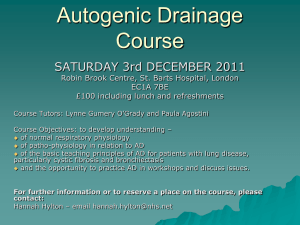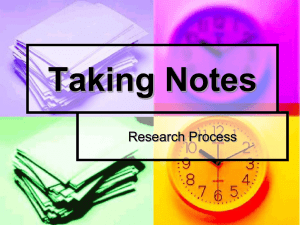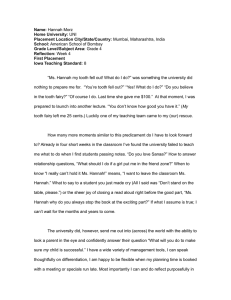Letter Knowledge: A Teacher`s Story
advertisement
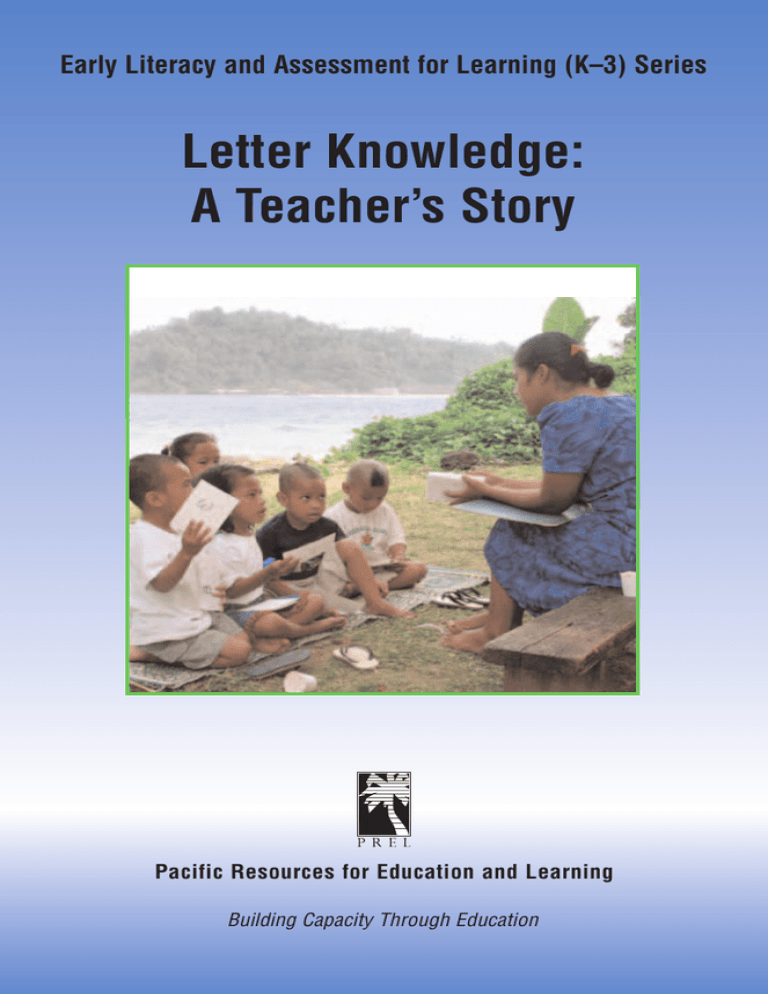
Early Literacy and Assessment for Learning (K–3) Series Letter Knowledge: A Teacher’s Story Pacific Resources for Education and Learning Building Capacity Through Education Written by the staff of the Pacific Communities with High-performance In Literacy Development (Pacific CHILD) project at Pacific Resources for Education and Learning. This product was funded by the U.S. Department of Education (U.S. ED) under the Regional Educational Laboratory program, award number ED01CO0014. The content does not necessarily reflect the views of the U.S. ED or any other agency of the U.S. government. © PREL 2004 Contents Hannah’s Story . . . . . . . . . . . . . . . . . . . . . . . . . . . . . . . . . . . . . . .1 Why Is Hannah Teaching Letters? . . . . . . . . . . . . . . . . . . . . . . . .2 How Does Hannah Assess Letter Knowledge? . . . . . . . . . . . . . . .2 Assessing Performance of Letter Knowledge . . . . . . . . . . . . . . . .4 Interpreting and Reflecting on Letter Knowledge . . . . . . . . . . . .4 Planning for Letter Learning: Resources . . . . . . . . . . . . . . . . . . .5 Teaching for Letter Learning: Activities and Strategies . . . . . . . .5 Lessons Learned . . . . . . . . . . . . . . . . . . . . . . . . . . . . . . . . . . . . . .8 Suggested Readings . . . . . . . . . . . . . . . . . . . . . . . . . . . . . . . . . . .10 Early Literacy and Assessment for Learning (K–3) Series i ii Pacific Resources for Education and Learning Hannah’s Story Hannah is a Pacific island grade 1 teacher in a local village school. She teaches in her native Pacific language and has established a 90-minute daily literacy block in which she focuses on literacy-related activities. As Hannah begins to prepare for the year and map out her ideas, she is aware of the need to gather basic information on each of her students. In the area of print literacy, she realizes how important it is to determine how her students know and use the symbols of the alphabet. Hannah decides to assess each student using an alphabet chart displaying both upper- and lowercase letters. She uses a recording form that allows her to collect information on whether her students are learning the letters by name and sound or are linking symbols to familiar words. With this information, Hannah feels she is better able to plan effective lessons for all her students. Sitting side by side with individual students to assess their needs is one way to begin gathering information. However, Hannah knows there are many other ways to collect information on how students know and use letters. She begins making observational notes on students who participate during regularly scheduled activities that involve the whole class. A few of these activities are shared writing (teacher and students collaborate on the text but the teacher does the writing), morning message (students read aloud a message that the teacher has written to the class while the teacher facilitates, after which attention to print becomes a mini-lesson), shared reading (teacher and students share the read-aloud experience), interactive writing (teacher helps students form and record text involving attention to aspects of print—teacher and students share the pen), and recording daily news (teacher acts as scribe as students dictate daily learning experiences or teacher encourages students to contribute by both recalling and writing the day’s events). Early Literacy and Assessment for Learning (K–3) Series 1 Throughout this booklet you will find out more about Hannah and her experiences in creating a rich learning environment that enhances letter learning for young students. She strives to increase her range of skills and to put strategies into practice that help her students learn how to learn. While reading this booklet, you may identify with many of Hannah’s experiences. However, you will want to craft activities and learning experiences unique to your practice and the individual needs of your students. Why Is Hannah Teaching Letters? Hannah knows that being able to recognize letters in both upper- and lowercase by name, sound, or word association is an important part of becoming print literate. Children need to become flexible with how they know letters. To be flexible with letters is to be able to recognize their form instantly, to identify the letter by name and sound regardless of the letter location (chart, book, or chalkboard) or how the letter is written (in crayon, marker, or pencil; large or small; upper- or lowercase). She knows that readers and writers use this information to help them decode (determine what the word is in print) and encode (determine how to spell the word they are writing). Being able to assess letter recognition is an important aspect of building letter knowledge. How Does Hannah Assess Letter Knowledge? Hannah assesses for learning; that is, she uses the information she collects to plan her lessons so that she can meet the needs of individual students. Hannah learns about her students’ letter recognition needs and interests by their performance, through observation, and by conversation (see Figure 1). 2 Pacific Resources for Education and Learning Figure 1. Three Pillars of Assessment Performance Conversation Assessment for Learning Observation Performance Hannah creates specific activities for her students to show which upperand lowercase letters they know by name, sound, or word and which they are not yet able to recognize. She uses this information to plan group and individual work specific to students’ needs. Observation Hannah listens carefully as students recognize upper- and lowercase letters in the various letter activities they do. She watches them name or sound out letters. She records what she observes and uses that information when planning the next day’s lesson. Her goal is to focus on each student at least once every 2 weeks and more often when possible. Conversation Hannah organizes a schedule to meet with each of her students at least once every 2 weeks to talk about what she has observed and to hear students’ perceptions of their own experience in knowing letters. They discuss what students can do to recognize upper- and lowercase letters quickly and easily by name and sound as they work toward becoming more fluent readers. Early Literacy and Assessment for Learning (K–3) Series 3 Assessing Performance of Letter Knowledge One tool Hannah uses for gathering student knowledge about letter recognition is the assessment that can be found in the pocket inside the back cover of this booklet. Before trying this activity, read the instructions carefully and practice with another teacher or older child. Be sure to make one copy of the recording form for each student being assessed. Put the alphabet chart in a plastic sleeve so it will be protected during the many times you use it. Interpreting and Reflecting on Letter Knowledge Hannah looks at the completed recording forms and writes down her thoughts. She identifies the following: • The letters that most of her students know and how they know them (by name, sound, or form)—She thinks about the different activities she can use with the students to build on these strengths. • A small number of students who do not yet know certain letter names, sounds, or forms—They may be confused by similar letter formations (e.g., n, h, and m) and inconsistent in demonstrating letter flexibility (the ability to draw on the letter attributes in a variety of ways). She puts these students together in a small group so she can work with them, giving explicit instruction that is tailored to their needs. • Individual students who need her help in recognizing many upperand lowercase letters—She plans specific activities to meet each of their needs. Hannah will observe regularly and reassess in a week the students for whom she has the greatest concern, noting the changes in their letter knowledge. She will regroup the students based on the new assessment information. For Hannah, this cycle is ongoing. She adjusts her plans as a result of the changing literacy needs of the students in her classroom. 4 Pacific Resources for Education and Learning Planning for Letter Learning: Resources Hannah recognizes the importance of providing instructional resources like alphabet charts, posters, puzzles, and cards for students to use on a daily basis. She further understands that having a variety of alphabet resources available contributes to students’ progress in developing letter flexibility. Many teachers find the alphabet linking chart (included in the pocket inside the back cover of this booklet) helps children associate letters with their respective sounds. As a reflective teacher, Hannah knows the key for effectively using these tools is giving explicit directions combined with modeling and repeated demonstration throughout the day and in a variety of situations. Teaching for Letter Learning: Activities and Strategies Teachers can use alphabet charts, posters, or cards in a variety of ways. Demonstrating flexibility with letters is particularly beneficial to young learners as they develop their skills. Teachers can call on students to respond to aspects of letters, such as characteristics (e.g., tall letters, letters with curves, letters with holes, letters with straight lines), name, sound, or both name and sound. Hannah learns from the information gathered during the letter recognition assessment that she has students with a wide range of abilities regarding letter identification and general letter knowledge. Several students need help identifying letters by name or sound, other students need assistance in learning letter formation, and some students need to acquire both skills. Early Literacy and Assessment for Learning (K–3) Series 5 To initiate student activities, Hannah made a few sets of alphabet cards. One set was for identifying letter pairs: The other set was for matching upper- and lowercase letters: Hannah is delighted to have activities that parent helpers and volunteers can assist with in the classroom. Volunteers can ask students to identify whether a specific letter is upper- or lowercase and consonant or vowel, to place letters in alphabetical order, or to name the missing letter from a short series of letters (e.g., a, b, _, d, e). Other activities include the following: • Ask students to name all their classmates whose first names begin with a certain letter or to name two or three items (articles of clothing, food, toys) that begin with the same letter sound as that of an identified letter. Using and solving language riddles, when appropriate, are also fun and engaging activities for students. For example: I’m thinking of a word that starts with b. It’s what I read here at school. It’s called a ____________. • 6 Have students pull small common objects from a bag and identify them by name. Encourage them to name the initial letter or sound of the object. This activity emphasizes articulating the beginning sound to reinforce meaningful conversations among and between students and the teacher or volunteer. A variation for this activity Pacific Resources for Education and Learning • • • is to have students say another word that starts with the same sound as the object pulled from the bag. Have students demonstrate letter formation by first viewing an alphabet card and then writing the letter in sand. Provide shallow trays with a thin layer of sand in each. Have volunteers (parents or upper grade students) work with small groups of students to create simple alphabet books that the students then illustrate. These resources are valuable contributions to student learning, as they increase the number of books available for classroom libraries. Create letter and word activities that require students to use their first names. After making an alphabet line and displaying it on the wall, have students place their individual name cards under the corresponding letter, as shown in Figure 2. This activity gives Hannah a chance to help students develop an awareness of letter frequency and letter-sound links associated with, in this example, their names. Figure 2. Students’ Names on an Alphabet Line Aa Ee Ii Oo Uu Kk Arleen Adanacio • Alberto Isaac Andonio Evahna Ioakim Admyra Isehia Ernista Omar Kimo Engage students in writing the daily or classroom news to help them explore certain words that begin with an identified letter and to demonstrate spelling techniques. Starting the day with a Early Literacy and Assessment for Learning (K–3) Series 7 morning message provides a prime opportunity to help students search for identified letters and spelling patterns. This activity also supports students in recognizing other aspects of print, such as punctuation, dates, names, and titles. Using cocreated writings or shared writings, ask individual students to use a pointing stick to show a word that begins with an identified letter. For example: Fernando, please show me a word starting with t. • Using alphabet posters and charts (specifically the alphabet linking chart), teach students to “read” a chart in a shared context (whole group together in unison), saying each letter name and the word represented by the picture. Once the students are familiar with a chart, help them learn to refer to it as they write words and stories. This helps them make letter-sound connections to the words they want to write. Charts can also be used to help students write or check on a letter form. For example, if they know the uppercase form of a letter and need to find the lowercase form, they can use the chart as a reference. After using the activities above, Hannah is pleased to see her students gaining letter flexibility. She realizes, however, that it is more important to give her students the strategies for learning the letters. These strategies have greater potential to empower students in the process of learning how to learn. Lessons Learned Hannah has shared many important lessons about letter knowledge: • Letter recognition is one important aspect of letter knowledge that contributes to learning to read in any alphabet language. 8 Pacific Resources for Education and Learning • • • Students need to become flexible with how they know letters. To be flexible with letters is to be able to recognize their form instantly, to identify the letter by name and sound regardless of the letter location (chart, book, or chalkboard) or format (written in crayon, marker, or pencil; large or small; upper- or lowercase). Teachers need to create opportunities to find out what each student knows about letters and his or her preferred way of recognizing letters. Teachers need to have the resources (materials and several instructional activities) readily available to help students gain flexibility in recognizing upper- and lowercase letters by name, sound, and form. Hannah now recognizes that one-time explicit teaching of a concept to the whole class does not guarantee that all students understand or learn Early Literacy and Assessment for Learning (K–3) Series 9 what she expects at that given time. She knows that she may not have all the answers and that she can refer to resource books, professional journals, and her colleagues for support and problem solving. Like Hannah, you may want to try out strategies that are new to you. Be inquisitive and experimental. Risk working in new and innovative ways. Do not be limited by a single example. You may have many great ideas and strategies that are not included in Hannah’s story. Suggested Readings Armbruster, B. B., Lehr, F., & Osborn, J. (2001). Put reading first: The research building blocks for teaching children to read. Kindergarten through grade 3. Washington, DC: The Partnership for Reading. Iversen, S. (1997). A blueprint for literacy success: Building a foundation for beginning readers and writers. Bothell, WA: The Wright Group. Pinnell, G. S., & Fountas, I. (1994). Guided reading: Good first teaching for all children. Portsmouth, NH: Heinemann. 10 Pacific Resources for Education and Learning Pacific Resources for Education and Learning 900 Fort Street Mall n Suite 1300 Honolulu, Hawai‘i 96813 Phone: (808) 441-1300 n Fax: (808) 441-1385 U.S. Toll-free Phone: (800) 377-4773 U.S. Toll-free Fax: (888) 512-7599 Email: askprel@prel.org n Website: www.prel.org Building Capacity Through Education ES0416
